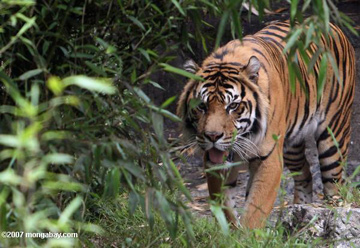New mapping system shows how detailed climate changes will affect species
New mapping system shows how detailed climate changes will affect species
Jeremy Hance, mongabay.com
August 6, 2008
Climate change will force some species into a ‘condemned cell’
|
|
A new computer simulation from the Nature Conservancy shows greater detail than ever before on how climate change will affect the world’s biodiversity, according to an article in New Scientist. In worst case scenarios—using the example of Bengal tigers in Sundarbans mangrove forest—the article’s author, Peter Aldhous, writes that some species will be forced into a “condemned cell”, literally having no-where to go while their region becomes inhabitable.
The Nature Conservancy’s new simulation hopes to reach scientists who have not yet had access to such models. ClimateWizard allows local researchers to select the region which interests them and then see how temperature and precipitation change under current predictions. This allows scientists worldwide to speculate about which species may successfully migrate to find suitable habitat and which may not. Interfacing ClimateWizard with Google maps further allows researchers to see animated maps of the changes expected to occur.
 Photo by Rhett A. Butler |
The biggest hurdle to overcome for developing ClimateWizard was providing a level of detail high enough to show changes in reserves of varied sizes (most climate models show climate in blocks of 250-600 kilometers across, which is far too large for species’ ranges). By focusing on how local climates are affected by factors like elevation and water sources, ClimateWizard provides greater detail. The program is able to show how climate has already changed in 4 kilometer blocks, while projected changes appears in 8 kilometer blocks, allowing for a much closer study of how ecosystems may be affected.
While scientists believe that while these models will prove invaluable in planning ahead, their data still needs to be treated with caution. Climate change, a massive and complex system, has proven to act at times erratically different from models’ predictions. Still, as climate understanding improves and models provide greater detail and variability, such simulations will become increasingly important in the role of conservation.
Some models—like those for the Bengal tigers of the Subdarbans—predict doom for a species local population. Even these simulations, as bleak as they are, are purposeful argues Sandy Andelman, head of the Tropical Ecology Assessment and Monitoring Network with Conservation International, “There’s so much focus now on energy security. I don’t think most people have made the connection to ecological and biodiversity security.”
Andelman believes such predictors are potent reminders to governments and the public-at-large of the need to take larger actions to mitigate climate change before the Bengal tiger’s range is swallowed by the sea.